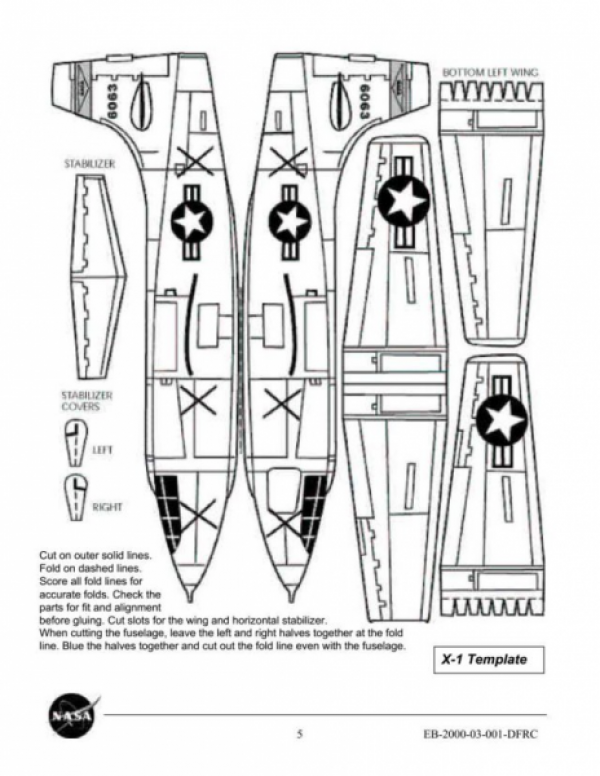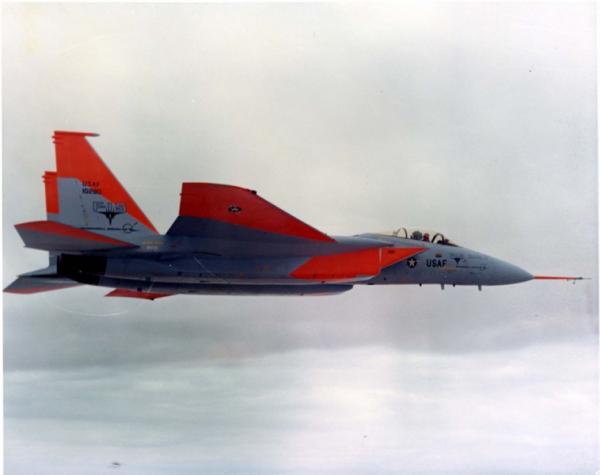The templates supplied with this activity allows you to build and experiment with all of these basic wing/tail/canard configurations. Eight different plastic foam “X-gliders” can be built using the template, but the total number of variations is only limited by the imagination of the “designer”
Build Gliders & Explore Flight
Canard (aeronautics)
In aeronautics, a canard (French for "duck") is a fixed-wing aircraft configuration in which a small horizontal surface, also named the canard or foreplane, is positioned forward of the main wing in contrast to the conventional position at the tail. Because of this it is sometimes described as "tail-first".
The term "canard" arose in France. The appearance of the Santos-Dumont 14-bis of 1906 reminded the French public of a flying duck (Fr. canard)., and later the Fabre Hydravion of 1910 was named "Le Canard". Thereafter all aeroplanes with a foreplane were known as canards.
More free content listed on Wikipedia, the free encyclopedia - Canard_(aeronautics)
About the Exhibition
How Things Fly Web site, a companion to the physical exhibition at the Smithsonian National Air and Space Museum. The goal is to explain the basic principles that allow aircraft and spacecraft to fly.
Distance Challenge
Controlled Flight
Forces of Flight |
How Wings Work
Paper Airplane Gallery
Hands-on Experiments |
Read More
Public Downloads
All items are free to view, share, and download.
When available, we provide all our content with a Spanish version in our public download section. You can find additional material from sources listed in all our articles.
 About Paper Airplanes
About Paper Airplanes
Download The Dart Paper Airplane Content
 Paper Plane Aircraft b1p1i3
Paper Plane Aircraft b1p1i3
 Paper Plane Aircraft b1p3i3
Paper Plane Aircraft b1p3i3
 Paper Plane Aircraft b1p3i5
Paper Plane Aircraft b1p3i5
 Paper Plane Aircraft b1p4i2
Paper Plane Aircraft b1p4i2
 Paper Plane Aircraft b1p5i1
Paper Plane Aircraft b1p5i1
 Paper Plane Aircraft b1p6i3
Paper Plane Aircraft b1p6i3
 Paper Plane Aircraft b1p7i2
Paper Plane Aircraft b1p7i2
 Paper Plane Aircraft b1p8i3
Paper Plane Aircraft b1p8i3
 Paper Plane Aircraft b3p4i5
Paper Plane Aircraft b3p4i5
Download Roundel Paper Airplane Content
 Paper Plane Aircraft b1p1i3
Paper Plane Aircraft b1p1i3
 Paper Plane Aircraft b2p1i3
Paper Plane Aircraft b2p1i3
 Paper Plane Aircraft b3p1i3
Paper Plane Aircraft b3p1i3
Download The Carnard Paper Airplane Content
 Paper Plane Aircraft b1p1i2
Paper Plane Aircraft b1p1i2
 Paper Plane Aircraft b2p1i3
Paper Plane Aircraft b2p1i3
 Paper Plane Aircraft b2p3i8
Paper Plane Aircraft b2p3i8
 Paper Plane Aircraft b2p4i3
Paper Plane Aircraft b2p4i3
 Paper Plane Aircraft b2p5i9
Paper Plane Aircraft b2p5i9
 Paper Plane Aircraft b2p6i1
Paper Plane Aircraft b2p6i1
 Paper Plane Aircraft b2p8i2
Paper Plane Aircraft b2p8i2
 Paper Plane Aircraft b2p8i3
Paper Plane Aircraft b2p8i3
Download The Delta Paper Airplane Content
 Paper Plane Aircraft b3p1i5
Paper Plane Aircraft b3p1i5
 Paper Plane Aircraft b3p3i3
Paper Plane Aircraft b3p3i3
 Paper Plane Aircraft b3p5i3
Paper Plane Aircraft b3p5i3
 Paper Plane Aircraft b3p7i1
Paper Plane Aircraft b3p7i1
 Paper Plane Aircraft b3p8i8
Paper Plane Aircraft b3p8i8
 Paper Plane Aircraft b3p9i3
Paper Plane Aircraft b3p9i3
 Paper Plane Aircraft b3p9i9
Paper Plane Aircraft b3p9i9
Description: The Canard has a long fuselage, delta wing and canard. A canard is a small wing placed on an airplane in front of the main wing.
Characteristics: The Canard is excellent for long-distance flights and flights requiring accuracy. Its forward wings give you extra control over its flying characteristics. The Canard is not nearly as fast as the Dart, but it is fairly stable.
An airplane wing affects moving air much like a rock in a stream affects moving water. The space around each wing is already +filled with air—there’s no empty space for air to move into. So as the oncoming air reaches the wing and moves over or under, it speeds up to squeeze between the wing and the surrounding air. This push is a force called lift.
Read More
Create your own paper plane print out with instructions.
Think your plane has the stuff to go pro? Check out the tips, tricks, and modifications and put your aircraft to the test!
Playlist: NASA's Space Place
What Is a Solar Eclipse?
For more information about safely viewing eclipses, visit:...
For more information about safely viewing eclipses, visit: https://solarsystem.nasa.gov/eclipses/safety/
Whoa! It’s the middle of the day—so why is the sky getting dark? It’s a solar eclipse! A solar eclipse happens when, ...at just the right moment, the moon passes between the sun and Earth.
Comprehension Questions:
1. What happens during a solar eclipse?
2. True or False: A partial solar eclipse always blocks all of the Sun’s light.
3. What is a path of totality?
4. The Sun’s atmosphere is called the ____________.
Answer Key:
1. The Moon passes between the Sun and Earth
2. False
3. Path of the Moon’s shadow
4. Corona
Find out more about the sun at https://spaceplace.nasa.gov/.
"Positive and Fun" by Scott Holmes
http://www.scottholmesmusic.uk
How Do We Know Earth Is Changing?
Scientists can use new and old pictures to keep track of Earth’s...
Scientists can use new and old pictures to keep track of Earth’s changes over time. Since Earth is where we live – and it’s the only planet we know of ...that we can live on – scientists are constantly observing its land, water, and air.
By capturing images from the ground and images from satellites in the sky, we can see how our planet is different than it used to be.
Find more images of our changing planet at
https://climate.nasa.gov/images-of-change
Find more fun videos, games, and articles about our planet at
https://climatekids.nasa.gov/
What Is an Aurora?
An aurora looks like a beautiful display of lights in the sky. We can...
An aurora looks like a beautiful display of lights in the sky. We can also see auroras from space! The name of an aurora changes depending on its location. If ...you’re in the northern hemisphere, it is called aurora borealis, or northern lights, and if you’re in the southern hemisphere, then it is called aurora australis, or southern lights.
So, what causes these beautiful displays of lights anyway? And how exactly does it work? Watch the video to find out!
Learn more about auroras at
https://spaceplace.nasa.gov/aurora/en/
Find more fun videos, games, and articles about space and Earth science at https://spaceplace.nasa.gov/
What Is a Nebula?
Nebulae are far away from Earth. We know what they look like because...
Nebulae are far away from Earth. We know what they look like because scientists use powerful telescopes to capture images of them. A nebula can take many different forms and ...shapes, but where did these stunning dust clouds come from?
Comprehension Questions:
1. What is a nebula made of?
2. How do scientists capture images of nebulae?
3. True or False: Nebulae can take many different forms and shapes.
4. Name one way a nebula can form.
5. Learning more about nebulae can help us better understand the lifecycle of stars, including our _______ — the most important star to our life here on Earth.
Answer Key:
1. Dust and gas or hydrogen and helium
2. [Powerful] telescopes
3. True
4. From the gas and dust of an exploded star or regions where new stars are beginning to form (supernova)
5. Sun
Learn more at
https://spaceplace.nasa.gov/nebula/en/
Find more fun videos, games, and articles about space and Earth science at https://spaceplace.nasa.gov/
What Causes Sea Level Rise?
People have been measuring local sea level at certain locations along...
People have been measuring local sea level at certain locations along the coasts for hundreds of years. And NASA has been measuring the global sea level for almost three decades. ...Over this time, scientists have observed that the global sea level has been rising. The ocean is about 7 to 8 inches higher now than it was a century ago.
Why? Because Earth is getting warmer.
Comprehension Questions:
1. What causes the level of the water to rise and sink all day long?
2. The average height of the ocean in a particular place is called the _______ _________ ________.
3. NASA measures the average sea level of the whole ocean from space. What is another name for the average sea level of the whole ocean?
4. True or False: As Earth warms, the ocean warms, too.
5. What is the name of the NASA satellites that measure global sea level?
Answer Key:
1. Waves and tides
2. Local sea level
3. Global sea level
4. True
5. Jason
Learn more at
https://climatekids.nasa.gov/sea-level/
Find more fun videos, games, and articles about our planet at
https://climatekids.nasa.gov/
How Do We Launch Things into Space?
You’ve probably seen beautiful photos of Earth and the other planets...
You’ve probably seen beautiful photos of Earth and the other planets in our solar system. Those photos were often captured by spacecraft – robotic explorers doing their work far away ...from Earth. But how exactly do we send these spacecraft so far away? Well, it all starts with a rocket. A really, really big one.
Comprehension Questions:
1. True or False: A rocket needs to get going to 17,800 MPH to thrust into Earth’s atmosphere and stay in orbit.
2. An object in space that orbits around a large object is called a ___________.
3. What is the name of the circular path that satellites follow around Earth?
4. The balance of momentum and _________ can keep a satellite in orbit for many years.
Answer Key:
1. True
2. Satellite
3. Orbit
4. Gravity
Learn more at
https://spaceplace.nasa.gov/launching-into-space/
Find more fun videos, games, and articles about space and Earth science at https://spaceplace.nasa.gov/
What Is the Greenhouse Effect?
Earth is a comfortable place for living things. It’s just the right...
Earth is a comfortable place for living things. It’s just the right temperatures for plants and animals – including humans – to thrive. Why is Earth so special?
Well, one reason ...is: the greenhouse effect!
Comprehension Questions:
1. The clear glass of a greenhouse allows sunlight to shine into the greenhouse, while also trapping the _______’s heat inside. This is how a greenhouse keeps plants warm, even at night and in the winter.
2. What is the name of the jacket of gases surrounding our Earth?
3. Name one of the greenhouse gases.
4. What kind of human activities can release more carbon dioxide into our atmosphere?
5. True or False: Extra greenhouse gases in our atmosphere cause our planet to warm up.
Answer Key:
1. Sun
2. Atmosphere
3. Any of the following: Water vapor; Carbon dioxide; Methane; Ozone; Nitrous oxide; Chlorofluorocarbons
4. Anything involving burning fossil fuels
5. True
Learn more at
https://climatekids.nasa.gov/greenhouse-effect/
Find more fun videos, games, and articles about our planet at
https://climatekids.nasa.gov/
Why Is the Sky Blue?
Why is the sky blue and not purple, green or orange? It's all because...
Why is the sky blue and not purple, green or orange? It's all because of how the Sun's light reaches Earth!
Comprehension Questions:
1. You can separate and see all the colors ...in white light if you shine sunlight through a specially shaped crystal called a _________.
2. True or False: Particles of dust, pollution, or smoke in the air can cause the whole sky to glow red.
3. Why do we only see blue light when we look up on a sunny day?
4. In what pattern does light travel?
Answer Key:
1. Prism
2. True
3. Blue light is scattered more than the other colors because it travels as shorter, smaller waves.
4. Waves
Learn more at
https://spaceplace.nasa.gov/blue-sky/
Find more fun videos, games, and articles about space and Earth science at https://spaceplace.nasa.gov/
Voiceover provided by NASA scientist Dr. Moogega Stricker
Our Moon Isn't the Only Moon!
Our Moon isn’t the only moon out there. In fact, some planets have a...
Our Moon isn’t the only moon out there. In fact, some planets have a lot of moons!
Comprehension Questions:
1. Why does our Moon appear so big and bright?
2. A moon is ...a natural object that __________ anything larger than itself.
3. True or False: Moons are always the same shape and size.
4. Which two planets have no moons at all?
5. What makes Jupiter’s moon Europa special?
Answer Key:
1. Because it’s closer to Earth than any other planet
2. Orbits
3. False
4. Mercury and Venus
5. There is thought to be a giant saltwater ocean under its surface
Learn more about which planets have moons, and which don’t at https://spaceplace.nasa.gov/how-many-moons/
Find more fun videos, games, and articles about space and Earth science at https://spaceplace.nasa.gov/
Voiceover provided by NASA scientist Dr. Moogega Stricker
The Solar System's Formation
In this episode, find out how our solar system formed and how it came...
In this episode, find out how our solar system formed and how it came to be the busy place it is today.
Comprehension Question:
1. Approximately how many billions of years ago ...did our solar system form?
Answer Key:
1. 4.6 billion years
For a transcript of this video and a fun downloadable poster, visit https://spaceplace.nasa.gov/solar-system-formation/en/.
Be sure to check out NASA Space Place for a ton of exciting activities, interesting articles, and cool games at https://spaceplace.nasa.gov/.
What is a Black Hole?
In this episode, find out how what a black hole is, how they can form,...
In this episode, find out how what a black hole is, how they can form, and why they are so cool!
Comprehension Questions:
1. A black hole is an area of such ...immense ______ that nothing—not even light—can escape from it.
2. What is a singularity?
3. What gives a black hole its color?
4. An ______ ______ is probably what you are thinking of when you think of a black hole.
5. How does spaghettification get its name?
Answer Key:
1. Gravity
2. The point where all the mass is trapped
3. Because the black hole sucks in everything, including light
4. Event horizon
5. As a spacecraft approaches a black hole, the gravity will be so much stronger on the side closer to the black hole than at the other side that it will get completely stretched out like a piece of spaghetti.
For a transcript of this video and a fun downloadable poster, visit https://spaceplace.nasa.gov/black-holes/en/
Be sure to check out NASA's Space Place for a ton of exciting activities, interesting articles, and cool games at https://spaceplace.nasa.gov/.
How does GPS work?
In this episode, find out how GPS works and how it can help you satisfy...
In this episode, find out how GPS works and how it can help you satisfy a late night pizza craving!
Comprehension Questions:
1. What does GPS stand for?
2. Your phone can ...determine where you are by listening to signals from _________ in the sky.
3. True or False: Any device with GPS is programmed to know where all the GPS satellites are at any given time.
4. How does a phone compute its location?
Answer Key:
1. Global Positioning System
2. Satellites
3. True
4. Potential answer: By identifying how far the satellites are and figuring out the amount of time it took for the signal to reach the satellite.
For a transcript of this video and a fun downloadable poster, visit https://spaceplace.nasa.gov/gps-pizza/en/
Be sure to check out NASA Space Place for a ton of exciting activities, interesting articles, and cool games at https://spaceplace.nasa.gov/.
What Is a Solar Eclipse?
For more information about safely viewing eclipses, visit: https://solarsystem.nasa.gov/eclipses/safety/
Whoa! It’s the middle of the day—so why is the sky getting dark? It’s a solar eclipse! A solar eclipse happens when, ...at just the right moment, the moon passes between the sun and Earth.
Comprehension Questions:
1. What happens during a solar eclipse?
2. True or False: A partial solar eclipse always blocks all of the Sun’s light.
3. What is a path of totality?
4. The Sun’s atmosphere is called the ____________.
Answer Key:
1. The Moon passes between the Sun and Earth
2. False
3. Path of the Moon’s shadow
4. Corona
Find out more about the sun at https://spaceplace.nasa.gov/.
"Positive and Fun" by Scott Holmes
http://www.scottholmesmusic.uk



































